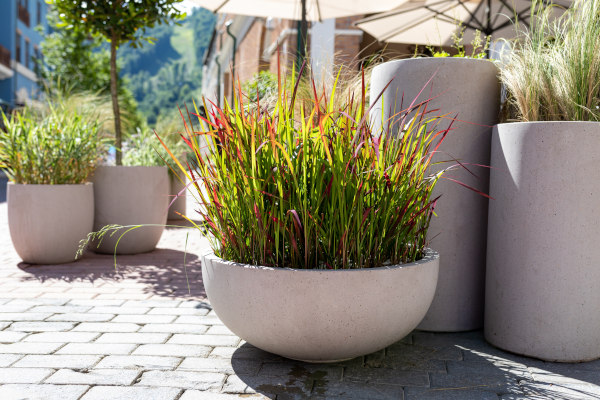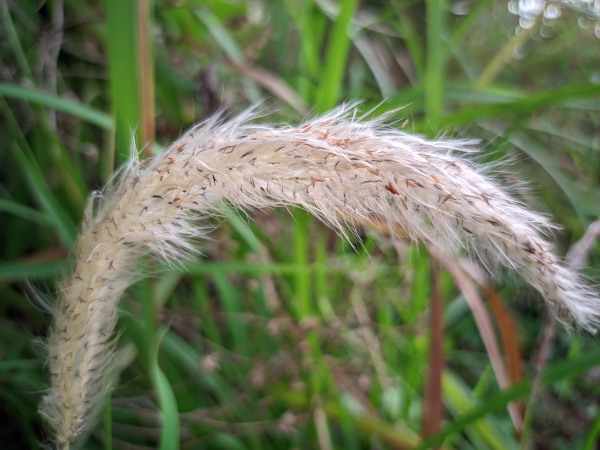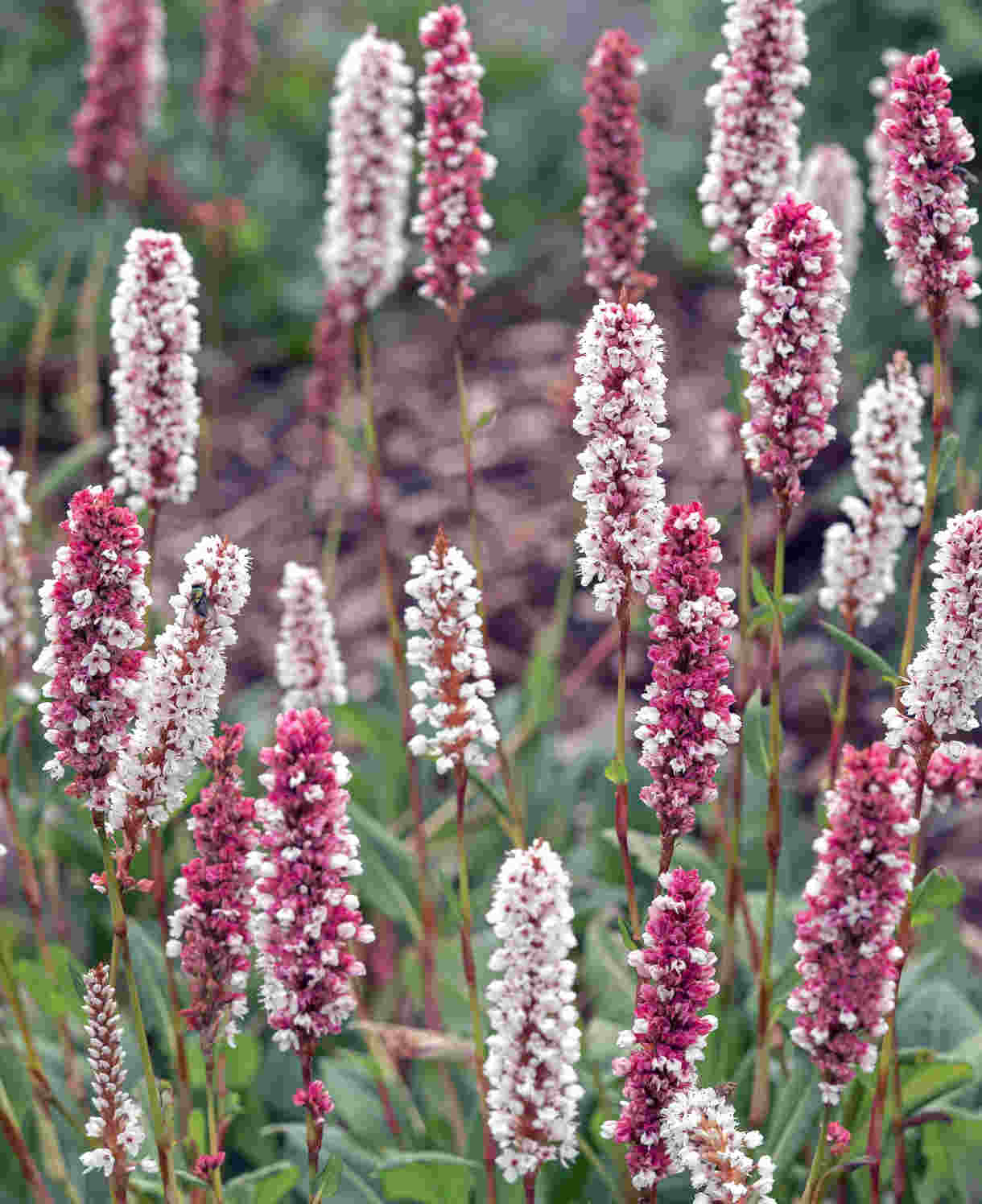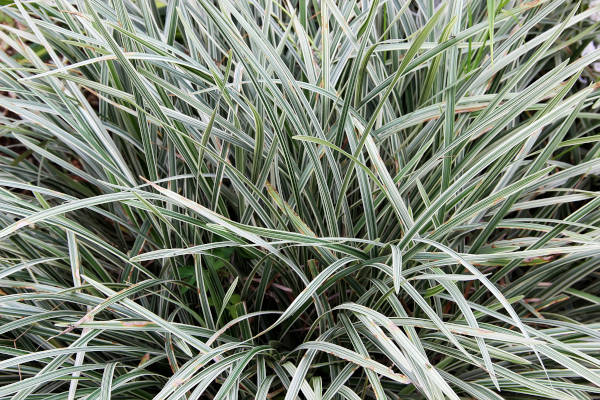How to grow Imperata
Also known as Japanese blood grass or cogongrass, imperata is a rhizomatous perennial from warm, open grassland habitats in Japan. While there are six species, only one is widely known – Imperata cylindrica. This plain green species spreads aggressively and is considered one of the most invasive weeds in the world. A red cultivated form, I. cylindrica ‘Red Baron’ (also known as ‘Rubra’), however, does not share the same invasive tendencies and is a popular ornamental garden plant.
‘Red Baron’ has slender, pointed, rich red leaves fading to green at the base. Over the course of the season the red deepens and intensifies, and, if it has been a warm summer, the leaves are joined by fluffy, silvery white flower panicles. By autumn the leaves become translucent and then eventually golden brown. Although deciduous, this grass remains attractive in its ‘withered’ winter state, and many gardeners delay cutting it back until early spring just before growth resumes.
One thing to keep an eye out for is any reversion to the pure green original species form. If you spot this, remove and dispose of these parts of the plant before they have a chance to become invasive.

Zantedeschia is a genus of flowering plants from the family Araceae and is native to southern Africa. With a rich history dating back to the Ancient Romans, these deciduous or semi-evergreen perennials have been used as a symbol of celebration. Zantedeschia was Named after Professor Giovanni Zantedeschia, an Italian botanist.
There are two main forms of Zantedeschia: hardy and tender. Hardy forms of the plant can be grown outdoors, enjoy moist soil and full sun or partially shaded conditions - these are known as Arum lilies. Tender forms of Zantedeschia prefer being grown in containers or pots and should be brought inside over the winter - these are known as Calla lilies.
With tuberous flora in all colours from whites, yellows and oranges to deep reds and purples, Zantedeschias are not to be overlooked in any garden, as long as they have sufficient sunlight to grow in.
Ready to learn more about growing Zantedeschia? Read on for all there is to know...

Key Information
Soil pH
Position
Hardiness


Where & when to plant Imperata
Position - Full sun or light dappled shade (the red colouring will be more vibrant in full sun).
Soil - Tolerant of many soil types, from moist and well-draining to sandy and poor. Try to avoid very rich soil as this can encourage aggressive growth.
Flowering Period - Late summer
Hardiness - Hardy with a rating of H4, meaning a minimum temperature range of -5°C to -10°C. It should be fine throughout most of the UK, though may suffer some winter damage in very cold or exposed spots.
Imperata hails from warmer climes than the UK, meaning a little thought is required when introducing it to our gardens. A spring planting will bring best results, giving your imperatus a growing season’s worth of root growth before being faced with the challenges of winter. Autumn is fine for those gardening in mild, well-draining conditions, though is probably best avoided if you get very cold, wet winters (usually those in more northerly spots). A summer planting is also an option, though be prepared to water frequently for the remainder of that growing season.
Imperata is well-suited to ornamental borders, where it will provide movement, texture, and a shock of colour over a long season. It can also be grown successfully in a container, and makes a striking and unusual edging plant for paths and driveways.
How to plant Imperata
- For planting in the garden, dig the soil area removing any large stones and weeds and breaking up any lumps. Mix in a little organic matter such as manure or garden compost. Rake level and firm with your heels. Rake level again.
- Water plants well and allow to drain before planting.
- Dig a hole twice the size of the root-ball.
- Place the plant in the hole, ensuring the top of the root ball sits level with the surface of the soil. Too low and the plant may rot, too high and the roots can dry out.
- Backfill with soil and firm in gently with your foot.
- Soak well with water.
- Mulch around the base with well-rotted organic matter.
- For planting in a container, first choose an appropriately sized pot. Imperata can be a tricky one to include in a mixed container, as its thick mass or roots tend to outcompete other plants. Instead, we advise giving it its own individual pot. Start just a few centimetres larger than the rootball and increase in size every year or two. It needn’t be especially deep, as imperata is fairly shallow rooting – a depth of 15cm will be enough. Ensure there are plenty of drainage holes in the bottom.
- If you are using a heavy pot, it can be a good idea to fill and plant it in situ to save yourself the trouble of moving once full.
- Use a good quality potting compost with plenty of horticultural grit mixed in, and, if not already present in the compost (check the description on the bag) some slow-release fertiliser granules.
- Start by partially filling the pot with compost; enough so that when placed on it the upper surface of the root ball is about 3cm lower than the top of the pot.
- Infill all the space surrounding the root ball with compost, firming down with your fingers then adding a little more so the plant is held tight.
- Pick up the container and lightly tap on the potting bench or ground a few times to help further settle the compost around the plant.
- Soak well with water.
- A mulch with horticultural grit will look attractive and help to prevent a ‘cap’ or crust forming on the top of the compost (something container plants can suffer due to the artificial nature of their watering).

What to plant with Imperata
At its most striking towards the end of the growing season, imperata goes well with other late summer perennials such as rudbeckia, crocosmia, echinacea, aster, dahlia, and persicaria. We also love mixing in a few other ornamental grasses to contrast and heighten the unusual red colouring of the leaves. Think stipa, pennisetum, and miscanthus.



How to care for Imperata
Pruning and Deadheading
While Imperata is deciduous, its mass of warm, faded golden leaves provide their own interest throughout winter. We therefore advise not cutting this plant back until early spring, unless you garden in a very cold spot and need to cover it with a protective winter mulch (see Cold Protection below). Chop the whole lot down to a couple of centimetres above ground level and wait for it to spring back to life with lots of fresh, new growth.
Remember also to check throughout the growing season for any parts or offshoots of the plant reverting to the pure green form, removing these as soon as you spot them.
Watering
Imperata is not a particularly thirsty plant, though does need watering in the early stages. When planting it in the open ground give a good initial soaking, and then a few more over that first summer while the roots establish. After this, Imperata is drought tolerant and should be largely self-sufficient.
Imperata grown in a container requires more help. Water regularly throughout each growing season. Allow the top few centimetres of compost to dry out each time, though be aware this can happen in as little as 24 hours during the height of summer.
Feeding
Imperata can thrive even in nutrient-poor soil, therefore it is not necessary to feed it. In fact, fertilising this plant can cause more harm than good in encouraging over-zealous and even aggressive growth.
When grown in the ground, an annual mulch with well-rotted organic matter, while not essential, won’t do any harm and offers the added benefit of suppressing weeds.
In a container, incorporating slow-release fertiliser granules into the compost will provide enough nutrients for the first year of growth. In subsequent years, a balanced liquid feed once or twice during the growing season will suffice. We would normally recommend a top dress in the years between potting and repotting, however Imperata’s dense mat of roots means the surface of the compost is likely to be unworkable.
Cold Protection
Imperata is hardy enough to withstand the average UK winter without the need for protection, though for those in very cold regions (usually this means in the northern half of the UK), or gardening in a particularly exposed spot, a little help may be required. Plants in the ground can be cut back in late autumn/ early winter and covered with a thick layer of mulch (something dry like straw, bracken, or bark chippings), while those in containers are best moved to a sheltered spot or wrapped in fleece or hessian.
Pests and Diseases
Imperata is considered trouble free. Its foliage is unpalatable to browsing wildlife such as rabbits and deer, making it a good choice for rural gardens.
How to propagate Imperata
The quickest and easiest way to propagate Imperata is to lift and divide established clumps in spring or early summer. As well as providing new plants this is recommended as a routine maintenance practice, done every few years to maintain the vigour of existing clumps. You’ll know it’s time to do this when the centre of the clump begins to die out, creating a ‘donut’ effect.
- Choose a day when the soil is not frozen or waterlogged.
- Dig the plant out of the ground.
- Shake off any excess soil.
- Separate the plant into sections using either swift, cutting blows with a sharp spade, or two forks inserted back-to-back with tines touching, handles then pushed together to prise the plant apart.
- Discard old, damaged, or surplus pieces, keeping healthy, vigorous material.
- Replant decent-sized pieces where desired, and any smaller bits can be potted up.
- Water well until fully established.
* Many plants carry Plant Breeders Rights and cannot be propagated for commercial purposes.
Common Imperata questions
Does Imperata spread?
The red cultivated form grown in gardens spreads gently via rhizomes and can be easily controlled by digging out any unwanted growth. As a sterile cultivar, it doesn’t produce viable seed
The straight species green form is, however, much more invasive and capable of spreading at an alarming rate, by both underground rhizomes and dispersal of seed. As cultivated forms can revert to their original species, it is important to keep an eye out and remove any of this as soon as you spot it.
Is Imperata hardy?
Its hardiness rating is H4, meaning fine throughout most of the UK though worth protecting in particularly cold conditions. See Cold Protection above.





